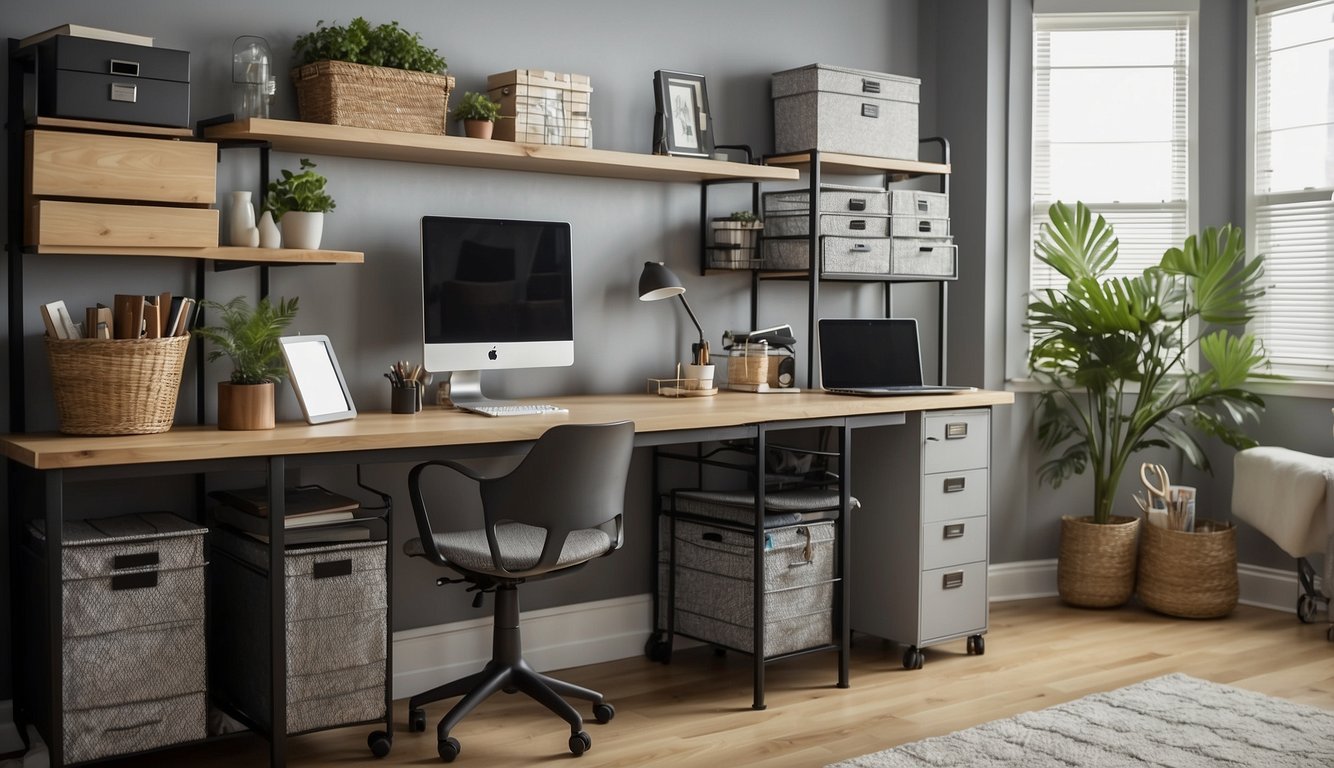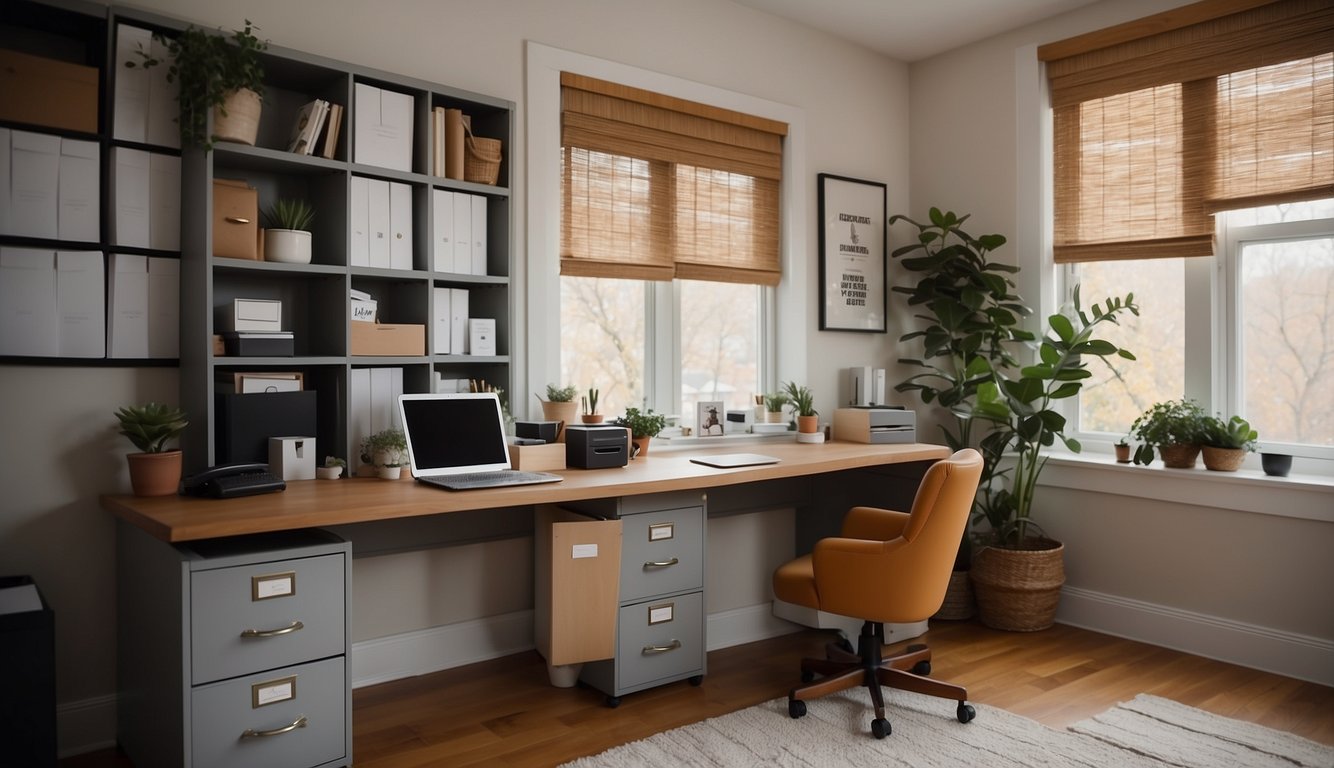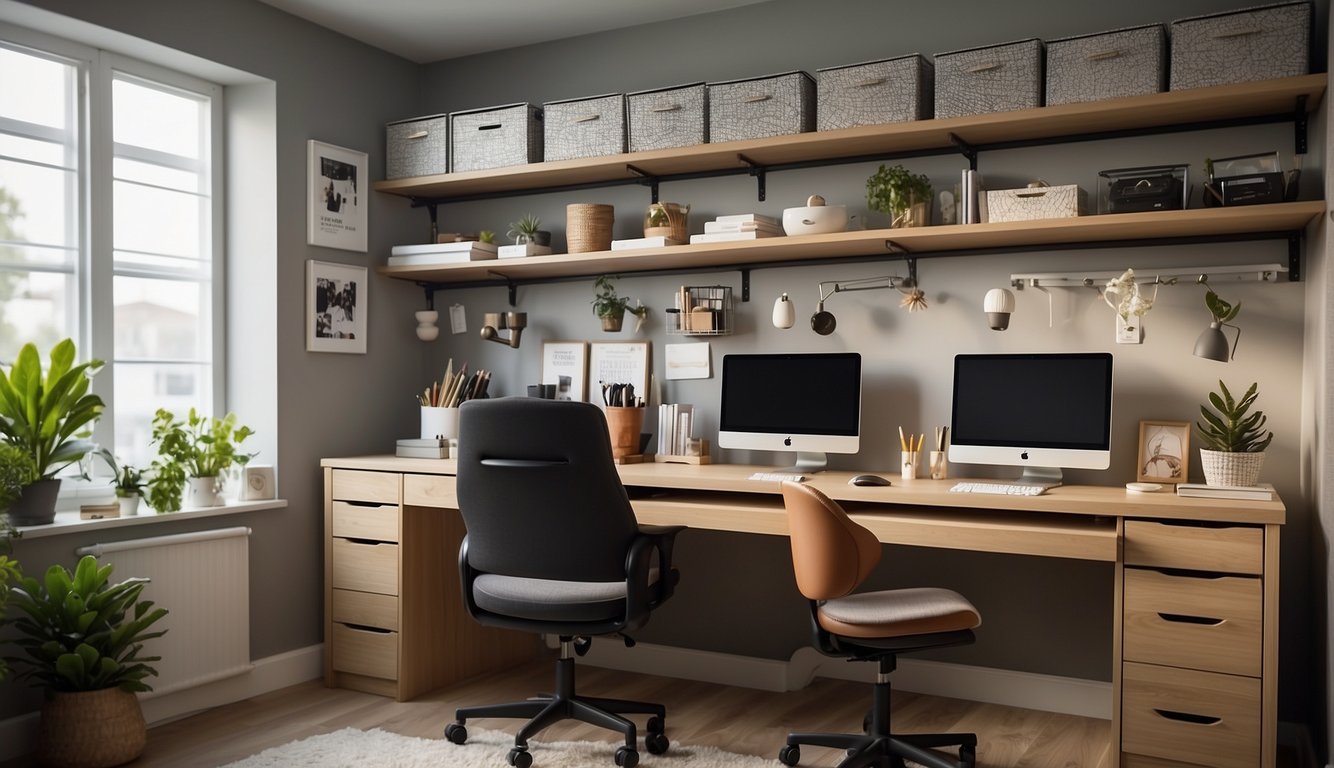10 Clever Storage Ideas for an Efficient and Tidy Home Office Setup
Crafting the ideal home office is as much about efficiency as it is about comfort. We understand that the line between personal and professional realms in our living spaces has blurred, making it essential to create an office that not only fosters productivity but also maintains work-life balance. An organized workspace is a launchpad for clear thought and sustained focus—a sanctuary where we can delve deep into our tasks without the distraction of disarray.
Storage solutions are integral to this effort, as they help us corral clutter and streamline our work environment. Whether we’re repurposing furniture or investing in new tools, we prioritize clever and versatile storage ideas that reconcile our professional needs with the limitations of residential space. By positioning our office essentials neatly and attractively, we reinforce a sense of order that permeates our work-life, allowing us to breathe easier and work smarter.
These curated storage ideas encapsulate practicality and style, designed to enhance the functionality of our home offices. We have scoured resources and pooled our collective knowledge to present you with savvy organization tactics that aim to convert any home office into a bastion of efficiency. Let’s navigate the often overlooked nooks and potential of our home office spaces together, transforming them into well-oiled machines for our everyday work endeavors.
Maximizing Wall Space
When organizing a home office, effectively using wall space is essential to create a clean and efficient workspace. Let’s take a look at how we can optimize this often-overlooked area.
Utilize Vertical Space
Why It Works: Leveraging vertical space helps to free up valuable desk and floor space, allowing for a less cluttered and more productive working environment.
How to Implement:
- Assess the Space: Start by evaluating your wall space to determine how much room you have to work with.
- Stack Storage: Install stacked shelves or hang multiple organizers to take advantage of the height of your walls.
Opt for Floating Shelves
Why It Works: Floating shelves offer a sleek, minimalistic look and are incredibly versatile for storing various office items while maximizing your wall space.
How to Implement:
- Choose the Right Shelving: Select floating shelves that suit your office’s aesthetic and can hold the weight of your items.
- Install at Varying Heights: Place shelves at different levels to accommodate items of various sizes and to create visual interest.
Selecting the Right Furniture
When organizing your home office, the right furniture can maximize space and foster productivity. We’ll focus on desks and storage units that offer both functionality and visual appeal.
Choosing a Desk with Adequate Storage
- Desk Size and Capacity: To optimize your workspace, choose a desk that fits your office dimensions while providing enough surface area and storage. Look for desks with built-in drawers, shelves, or compartments.
- Customization: Consider a modular desk with adjustable components. This allows you to add or remove features like trays and organizers, thereby adapting the desk to your evolving needs.
Incorporating a Multifunctional Credenza or Hutch
- Credenza Utility: A credenza offers a broad surface for printers or decorative items and usually includes a combination of shelves, drawers, or cabinets below for concealed storage.
- Hutch Benefits: For vertical space, attach a hutch above the desk or credenza. This provides additional shelving, which is perfect for keeping reference materials and office supplies within easy reach.
Effective Use of Storage Units

When organizing a home office, the selection and arrangement of storage units can drastically improve efficiency and reduce clutter. Using a combination of filing cabinets, bookshelves, and drawer organizers not only maximizes space but also ensures that every item has a dedicated spot.
Incorporating Filing Cabinets and Bookshelves
Filing Cabinets:
- Purpose: Store important documents categorically.
- Tips:
- Use hanging file folders for categorization.
- Label each drawer for quick retrieval.
Bookshelves:
- Function: Hold books, binders, and decorative items.
- Tips:
- Arrange items by height to maintain visual balance.
- Use bookends to keep items upright and organized.
Utilizing Drawer Dividers and Organizers
Drawer Dividers:
- Usage: Create compartments within drawers for small supplies.
- Implementation:
- Measure drawers before purchasing dividers to ensure fit.
- Group similar items together to save time.
Drawer Organizers:
- Advantage: Keep frequently used items within reach.
- Implementation:
- Choose adjustable organizers to suit changing storage needs.
- Consider clear materials for easier identification of contents.
Devising an Organizational System
Before diving into specific organizational strategies, it’s crucial to recognize that a coherent system is the bedrock of any efficient home office. We ensure that every item has a designated place, and every document is easily retrievable.
Implementing a Labelling System
Labels are indispensable in maintaining an organized space. For tangible success, we adopt a labelling system that is:
- Consistent: Use the same labelling format throughout your space.
- Clear: Opt for legible, easy-to-read fonts and colors that stand out.
Steps to Implement:
- Identify categories for labelling (e.g., “Financial,” “Projects,” “Personal”).
- Select a labelling format (e.g., printed labels, hand-written tags).
- Apply labels to all storage containers, drawers, and shelves.
By clearly labelling storage locations, we eliminate guesswork and reduce time spent searching for items.
Developing a File Categorization Strategy
Effective filing systems enable us to categorize documents quickly and methodically. A nuanced strategy considers:
- Frequency of Use: Place frequently accessed files within arm’s reach.
- Relevance: Group related documents together to streamline retrieval.
Categorization Tips:
- Use broad headings to group files, then subdivide into detailed subcategories.
- Incorporate color-coding for quick visual identification.
Filing System Example:
| Main Category | Subcategory | Color |
|---|---|---|
| Financial | Invoices | Blue |
| Financial | Tax Documents | Green |
| Projects | Current | Yellow |
| Projects | Completed | Red |
By curating a comprehensive file categorization strategy, we ensure that important documents are always at our fingertips, empowering our productivity.
Keeping Clutter at Bay

In a home office, a clutter-free environment is crucial for maintaining focus and productivity. Here, we’ll explore how regular decluttering sessions and strategic storage solutions can create a more organized workspace.
Regular Decluttering Sessions
Why it works: Scheduling frequent decluttering sessions keeps our office environment free from accumulated clutter, making us more efficient and less stressed.
- Set a schedule: We recommend setting aside dedicated time each week to sort through papers, old notes, and miscellaneous items that tend to pile up.
- Keep, toss, file: During each session, we make immediate decisions to keep, discard, or file each item. This prevents the build-up of unnecessary clutter and keeps our desks clear.
Strategic Storage for Office Supplies
Why it works: Having specific places for each item helps prevent clutter and ensures that office supplies are easily accessible when we need them.
- Utilize vertical space: Wall-mounted shelves and wire boards take advantage of vertical space without overcrowding the desk.
- Hidden storage options: An ottoman or storage bench provides seating as well as a concealed area for supplies we don’t use daily.
- Label and categorize: Clear labeling of storage containers and shelves directs us exactly where to put things away, reducing the chance for clutter to arise.
Innovative Storage Solutions and Accessories

In our quest for organization, we focus on storage solutions and accessories that enhance both functionality and aesthetics.
Utilizing Pegboards and Corkboards
Pegboards and corkboards are versatile tools for office organization. Pegboards offer flexible storage options, allowing us to hang accessories such as shelves, bins, and holders in a customizable layout. For a quick start:
- Purchase a pegboard that fits your office space.
- Add a mix of hooks, shelves, and containers to hold a variety of office items.
Corkboards are great for visual planning and keeping track of important notes. Tips for effectiveness:
- Position your corkboard within easy line of sight from your workspace.
- Use color-coded pins to categorize tasks or projects.
Choosing the Right Bins and Containers
Selecting the right storage bins and containers can lead to a neat and systemized office space. Specific points to consider:
- Match bin sizes to the items for storage to maximize space efficiency.
- Use transparent bins for easy identification of contents, or label opaque ones clearly.
Implementing these storage solutions and incorporating practical accessories can drastically improve the orderliness and efficiency of our home office environments.
Let Us Know How We’re Doing!
Did this expertly prepared resource answer your question?
Do you have another question about home maintenance, home improvement projects, home appliance repair, or something else?
Get more information, send in questions and keep the discussion going by contacting the I’ll Just Fix It Myself company customer service team at at 1-800-928-1490 or Email us at [email protected]
